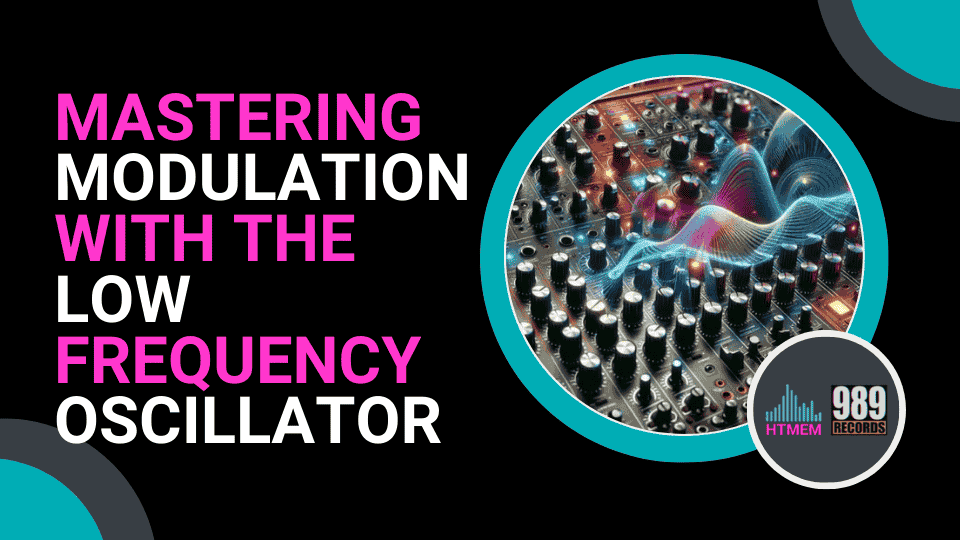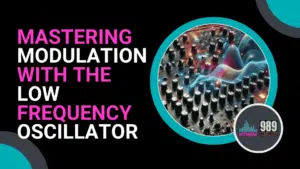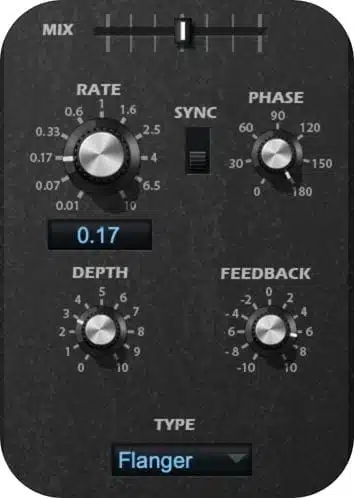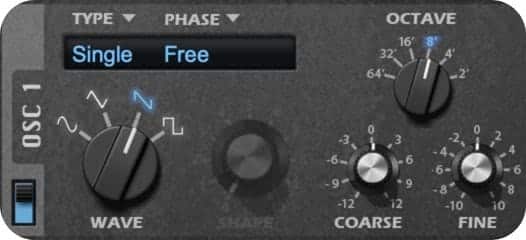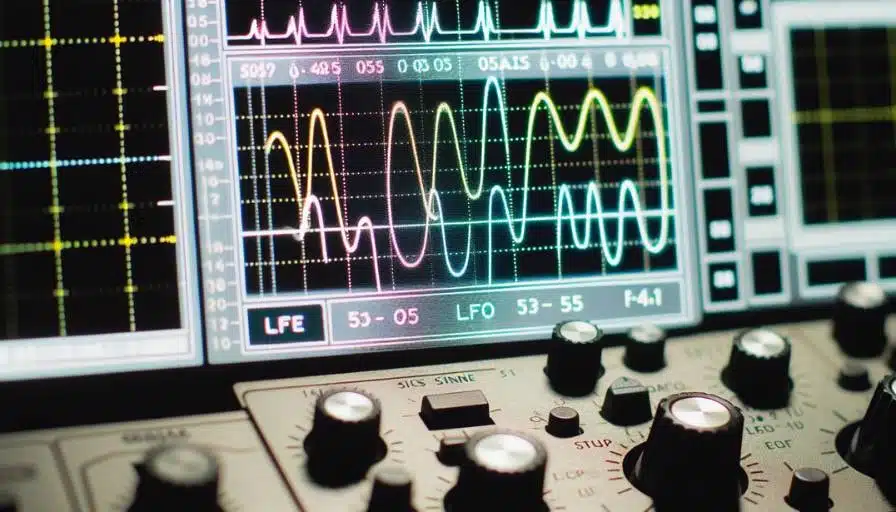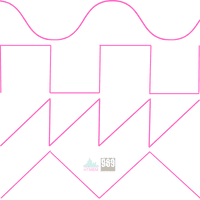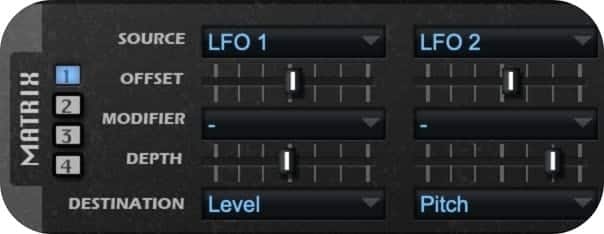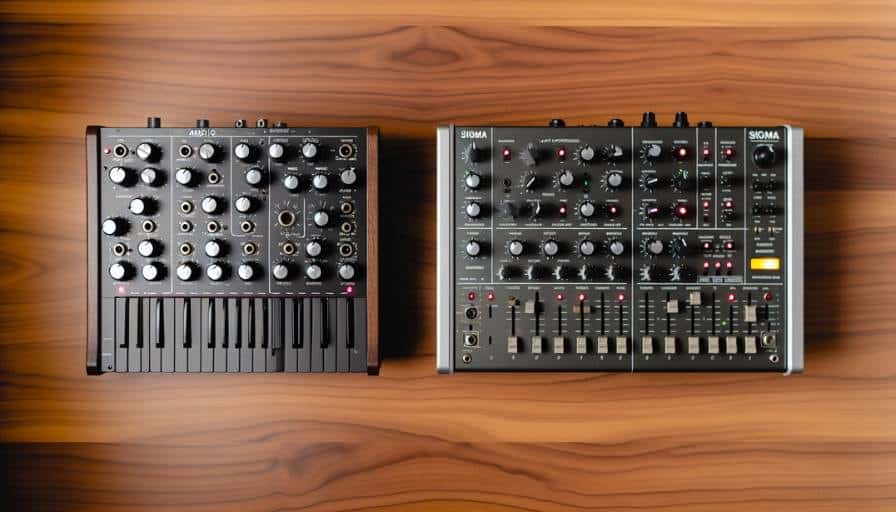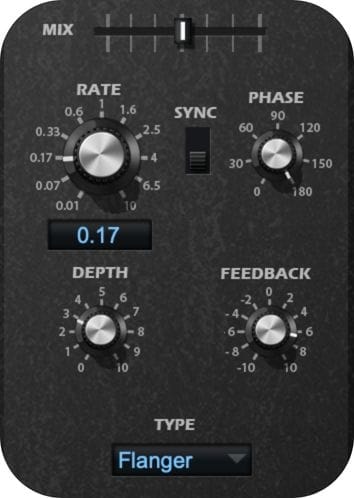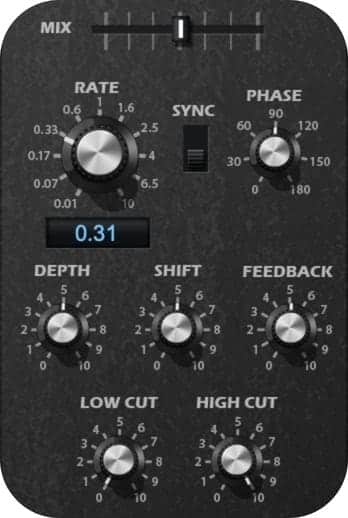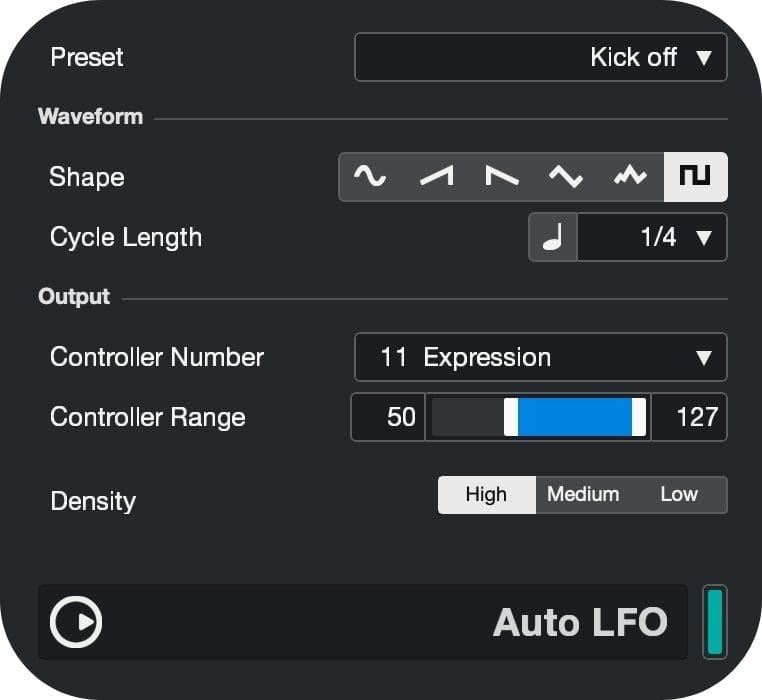Low Frequency Oscillators (LFOs) are pivotal for creating dynamic audio effects in music production. Functioning below our audible range, these tools, also known as low frequency oscillator, modulate other sound parameters – not to make sounds themselves, but to infuse tracks with rhythm, depth, and character.
Let’s understand something More
Key Takeaways
- Low Frequency Oscillators (LFOs) function below the human hearing threshold to modulate various sound parameters such as pitch, volume, and timbre, differentiating it from audio oscillators that create audible sound.
- LFOs have key parameters including wave shapes, rate, and depth, which, when manipulated, can produce a vast array of modulation effects, from subtle nuances to pronounced transformations.
- The creative applications of LFOs extend to evolving soundscapes, rhythmic patterns, and stereo movement, enhancing depth and dimension in music production across various genres and styles.
Understanding Low Frequency Oscillators (LFOs)
Dynamic sound modulation is primarily steered by the Low Frequency Oscillator (LFO).
LFOs are unique oscillators that operate at frequencies below the threshold of human hearing, typically below 20Hz. They serve a critical role in music synthesis, enriching the sonic landscape by adding movement and complexity through signal processing.
However, the magic of LFOs doesn’t end there.
They set themselves apart from their counterpart, the audio oscillator, which is designed to produce sounds within the human hearing range. So, how exactly do these LFOs function, and how do they differ from audio oscillators?
Let’s explore.
What is an LFO?
Operating at low frequencies, the Low Frequency Oscillator (LFO) generates waveforms for sound synthesis and modulation through low frequency oscillation.
Its name directly reflects its function in signal processing. But what sets it apart from other oscillators?
It’s all in the frequency. LFOs operate at a very low frequency, typically below 20Hz, which is outside the human hearing threshold. This is their defining characteristic.
While audio oscillators produce sounds we can hear, LFOs work behind the scenes, modulating various sound characteristics to create dynamic effects such as rhythmic pulses and sweeps, using a low frequency signal and frequency modulation.
Sine Wave Without LFO
The LFO is like the invisible puppet master, controlling the movements of the puppet (the sound) to produce a captivating performance.
Sine Wave With 1 Hz LFO
By modulating parameters like volume, pitch, and filter cutoff frequency, LFOs bring your sounds to life, introducing movement where there is static, and variation where there is monotony.
The LFO is truly the unsung hero of dynamic sound design.
LFO vs Audio Oscillator
Having established what an LFO is, it’s time to distinguish it from an audio oscillator.
An audio oscillator is the sound generator in music production. It churns out repeating waveforms that, when altered and shaped, become the diverse sounds you hear in music.
On the other hand, LFOs control the movement and modulation of these sounds. They are responsible for the dynamic alterations in pitch, volume, or timbre that add depth and complexity to your music through various modulation effects.
While audio oscillators are the architects of sound, building the fundamental structures that we perceive as music, LFOs are the decorators, filling those structures with color, texture, and dynamism.
It’s the interplay between these two types of oscillators that makes music synthesis so rich and captivating.
LFO Parameters: The Building Blocks for Modulation
Understanding the key parameters of LFOs – wave shapes, rate, depth, and control voltage – is fundamental to mastering modulation.
These parameters are like the artist’s tools, each contributing to the final masterpiece in its unique way. The wave shapes define the rhythm and character of the modulation, the rate controls the speed, the depth determines the intensity, and the control voltage allows for precise adjustments.
By manipulating these parameters, you can create an infinite variety of modulation effects, from subtle shifts to dramatic transformations.
And now, let’s examine each of these parameters in more detail.
Wave Shapes
Wave shapes are the fundamental building blocks of any LFO signal. They define the rhythm and character of the modulation. The most common wave shapes generated by LFOs are:
- Sine
- Square
- Sawtooth
- Triangle
Each wave shape has a distinct influence on sound modulation, leading to a wide range of sonic possibilities.
Different wave shapes have different impacts on modulation. In the context of a modulation matrix, here are a few examples:
- A sine wave results in smooth and gentle modulations, ideal for creating a balanced modulation effect.
A Classic Sine Wave Without LFO
- A square wave results in distinct on/off modulation, perfect for maximizing the intensity of the effect.
Square Wave Without LFO
- The sawtooth wave generates a progressively dynamic and vibrant sound when applied to modulate a filter.
SawTooth Without LFO
And, finally, the Triangle wave, produces a softer and smoother sound, often used in creating subtle changes in pitch or volume.
Triangle Without LFO
Understanding these wave shapes and their impact on modulation is key to mastering the power of LFOs.
Rate and Depth
Rate and depth are two other vital parameters of an LFO.
The rate parameter controls the frequency of the oscillation, often referred to as the modulation rate. It directly influences the speed of modulation, with faster rates producing rapid effects and slower rates leading to more gradual changes in the sound. Slower rates, for instance, can be used to create a slow, sweeping effect, while faster rates can create a rapid, pulsating effect.
LFO Rate
On the other hand, the depth parameter regulates the intensity of the modulation effect. Increasing the depth leads to a more conspicuous modulation effect while reducing it produces a more subdued modulation influence.
LFO Cutoff, Volume, and Pitch
This is the power of routing options in LFOs.
Creative Applications of LFOs in Music Production
Having explored the mechanics of LFOs and their parameters, it’s time to examine their creative applications in music production. LFOs can be used to create a wide range of effects, including:
- Creating evolving pads and soundscapes
- Shaping rhythmic patterns
- Pulsating basslines
- Adding stereo panning and movement to tracks
- Enhancing the depth and spatial perception of your mix
- Synth modulation for dynamic sound design
Let’s explore these applications further.
Evolving Pads and Soundscapes
LFOs can be used to create evolving pads and soundscapes, adding an atmospheric dimension to your music. By modulating parameters such as filter cutoff and resonance modulation,
LFOs can transform a simple, static sound into a rich, evolving soundscape.
For instance, using a slow sine wave LFO to modulate the filter cutoff can create a beautiful, sweeping effect, with the sound gradually brightening and darkening over time.
Similarly, using a fast square wave LFO to modulate resonance can create a rhythmic, pulsating effect, adding a sense of movement and rhythm to your pads.
Evolving Pad – Cutoff + Resonance
These techniques can be used in a variety of musical genres, from ambient and electronic music to film scores and sound design.
Rhythmic Patterns and Pulsating Basslines
Rhythmic patterns and pulsating basslines are another creative application of LFOs.
By modulating parameters such as volume, pitch, or filter cutoff, you can create engaging rhythms that complement your compositions.
For instance, using a square wave LFO to modulate volume can create a pulsating rhythm, adding a sense of groove and movement to your basslines.
Similarly, using a sawtooth wave LFO to modulate pitch can create a rising and falling effect, adding a sense of tension and release to your rhythms.
Rhythmic Patterns and Pulsating Basslines
These techniques, when combined with tempo sync, can add a rhythmic backbone to your tracks, driving the energy and momentum of your music.
Stereo Panning and Movement
Stereo panning and movement can add a sense of depth and space to your mix.
By using LFOs for panning modulation, you can create a sense of movement, making your tracks feel more dynamic and immersive.
For instance, using a slow sine wave LFO to modulate the pan position can create a sweeping effect, with the sound moving from left to right in a smooth, fluid motion.
Stereo Panning Slow
Similarly, using a fast square wave LFO to modulate the pan position can create a more dramatic, back-and-forth effect, adding a sense of tension and excitement to your mix.
Stereo Panning Fast
Implementing these techniques can elevate your music, infusing it with vibrancy and a sense of vitality.
LFOs in Synthesizers: Analog vs Digital
Analog and digital synthesizers, though different in their construction and sound production, both utilize LFOs to modulate parameters and create dynamic sounds. One key aspect of this modulation is the modulation depth, which determines the extent to which the LFO affects the parameter.
However, digital synthesizers offer more advanced modulation options and complex routing capabilities, opening up a world of sonic possibilities.
So, let’s investigate the use of LFOs in both analog and digital synthesizers.
Analog Synths
Analog synthesizers, with their warm, organic sound, make extensive use of LFOs to modulate parameters. This results in dynamic sounds that have a distinct analog character, rich with depth and complexity. The use of LFOs in analog synths often involves analog modulation, which enhances the richness and depth of the sound.
For instance, as seen before, you can use an LFO to modulate the pitch of an oscillator, creating a vibrato effect.
Or you can use it to modulate the filter cutoff, creating a rhythmic, pulsating effect.
There are a lot of possibilities, and the resulting sounds are uniquely analog, with a warmth and richness that’s hard to replicate digitally.
Digital Synths
On the other hand, digital synthesizers offer more advanced LFO options, opening up a world of creative possibilities through digital modulation.
With digital synths, you’re not limited to a single LFO. You can use multiple LFOs to modulate different parameters, creating complex and evolving sounds.
Again, as seen before, you can use one LFO to modulate the pitch of an oscillator, creating a vibrato effect, while using a second LFO to modulate the filter cutoff, creating a rhythmic, pulsating effect.
Or you can use an LFO to modulate the rate of another LFO, creating complex, evolving modulation effects.
The possibilities here are even more vast, and the resulting sounds can be incredibly intricate and rich.
LFOs in Effects Processing
Effects processing is another area where LFOs can work their magic. By employing various modulation techniques, LFOs can be used to create a variety of effects, including:
- Swirling chorus
- Flanger effects
- Psychedelic phasers
- Rhythmic tremolos
LFOs, through LFO modulation, play a crucial role in shaping the character of your effects as the LFO oscillates.
We should examine how these effects processing techniques utilize LFOs.
Chorus and Flanger
Chorus and flanger effects use LFOs to modulate the delay time through delay modulation, creating a swirling, spatial sound that can add depth and richness to your mix.
The chorus effect, for example, uses an LFO to modulate the pitch of a duplicated signal, creating a shimmering, thickening effect.
Chorus
On the other hand, the flanger effect uses an LFO to modulate the delay time of a duplicated signal, creating a sweeping, jet-like sound.
Flanger
By adjusting the rate and depth of the LFO, you can control the speed and intensity of these effects, adding movement and animation to your sounds.
Phaser and Tremolo
Similarly, phaser and tremolo effects also make use of LFOs.
The phaser effect uses an LFO to modulate the phase of a duplicated signal, creating a sweeping, whooshing sound that’s often associated with psychedelic music.
Phaser
The tremolo effect, on the other hand, uses an LFO to modulate the volume of the signal, creating a rhythmic pulsing or shaking effect. This volume modulation is key to achieving the characteristic tremolo sound.
Tremolo
By tweaking the rate and depth settings of the LFO, you gain command over the tempo and strength of these effects, injecting your music with a rhythmic flair.
The Modulation Matrix: Advanced Controls
The modulation matrix is a game-changer in the realm of music production, offering unparalleled control over LFO modulation. Think of it as the command center where you can route multiple LFOs to various parameters, crafting intricate and dynamic soundscapes that evolve over time.
Mastering LFO Techniques in Steinberg Cubase
Steinberg Cubase is a robust digital audio workstation that offers powerful tools for mastering LFO techniques. With its user-friendly interface, advanced modulation options, and a comprehensive modulation matrix, Cubase can help you take your LFO skills to the next level.
Let’s examine the ways to modulate parameters and work with multiple LFOs in Cubase. BOTTONE – LEARN CUBASE NOW
Modulating Parameters in Steinberg Cubase
Modulating parameters in Steinberg Cubase allows for precise control over LFO effects.
Cubase offers a range of tools for parameter modulation, from the Auto LFO plugin, which is compatible with MIDI CC, to the ability to modulate third-party plugin parameters by making adjustments to specific settings within the plugin.
Whether you’re modulating a synth’s filter cutoff or a delay effect’s feedback level, Cubase gives you precise control over the modulation parameters, allowing you to shape your sounds exactly as you want.
With Cubase, you can create everything from subtle modulation effects to dramatic transformations, all with a few clicks of the mouse.
Working with Multiple LFOs
Working with multiple LFOs in Cubase enables the creation of intricate modulation effects, resulting in unique and engaging music productions.
Cubase allows you to create modulation modules that can be used as a source by any parameter capable of automation, allowing for the creation of intricate modulation effects.
For instance, you can use one LFO to modulate the pitch of a synth, while using a second LFO to modulate the filter cutoff, creating a complex, evolving sound.
Or you can use an LFO to modulate the rate of another LFO, creating a complex, evolving modulation effect. With Cubase, the possibilities are vast, allowing for a level of creativity and complexity that’s hard to match.
Learn How to Produce Music with Cubase
Summary
As we’ve seen, Low Frequency Oscillators (LFOs) are essential in shaping the character and movement of sounds in music production.
From defining the rhythm and texture of a sound with varying wave shapes and controlling the speed and intensity of modulation with rate and depth to creating complex and evolving sounds with routing options, LFOs provide a world of possibilities for creating dynamic and engaging music.
Whether you’re working with analog synths, digital synths, or effects processing, mastering the art of LFOs can significantly enhance your sound design skills. And with powerful tools like Steinberg Cubase, you can take your LFO skills to the next level, modulating parameters and working with multiple LFOs to create unique and engaging music productions. So, go forth, experiment, and let the power of LFOs transform your music.
Personal Experience and Advanced Applications
As a Steinberg Certified Trainer with over 30 years in the industry, I’ve implemented LFOs in countless productions across various genres. One of my favorite techniques is layering multiple LFOs at different rates to create evolving textures that seem almost alive. In my experience, I’ve found that subtle LFO modulation on ambient pads can transform a static background element into the emotional core of a track.
Technical Deep Dive: Beyond the Basics
Let’s now explore some advanced LFO applications that I’ve refined over decades of production work. When working with modular systems, I often use sample and hold modulation (a stepped random waveform) to create unpredictable, glitchy variations that work brilliantly for experimental electronic music.
Another powerful technique is using an envelope follower to dynamically adjust the LFO rate based on input signal amplitude—this creates responsive modulation that adapts to your performance dynamics. According to research by the Journal of Audio Engineering (Vol. 58), these types of dynamic modulation techniques have been shown to significantly increase listener engagement.
Practical Applications in Popular DAWs
In Ableton Live, you can create complex LFO routing using Max for Live’s LFO device, allowing for multiple modulation targets simultaneously.
In Logic Pro, the newly redesigned modulation matrix offers incredible flexibility for complex LFO setups.
In FL Studio, the Peak Controller can be used alongside traditional LFOs for envelope-following modulation effects.
Here’s how I approach LFO setup in these different environments:
- Ableton: Map Max for Live’s LFO to multiple parameters with different scaling values
- Logic: Use Smart Controls to route multiple LFOs to different plugin parameters
- FL Studio: Combine Peak Controller with standard LFOs for dynamic modulation
Case Study: LFOs in Contemporary Production
In my work with EDM producers, I’ve observed a trend toward using precisely synchronized LFOs to create the distinctive “movement” heard in genres like future bass and melodic techno. For example, on the track Orchid, I used three synchronized LFOs with different wave shapes to create the characteristic wobbling pad sound. The first LFO modulated filter cutoff, the second affected reverb size, and the third controlled panning—resulting in a truly three-dimensional sound that moves through the stereo field while evolving timbrally.
Frequently Asked Questions
Which Oscillator is Used for Low Frequency?
An LFO (Low Frequency Oscillator) is used for low frequency, typically below 20 Hz, and is out of the range of human hearing. It is utilized to influence parameters in synthesis to create movement and depth in sound.
What is an Example of LFO?
An example of an LFO is when it’s used in electronic music, such as in dubstep and drum and bass, to create a “wobble” effect in bass sounds by modulating the cutoff frequency of a low-pass filter. This is a common practice that adds dynamic movement to the music.
How Does LFO Work?
LFOs work by generating a slowly oscillating signal that can be used to modulate other parameters in a synth or effect. For example, it can be routed to modulate the pitch of an oscillator to create a vibrato effect.
What is the Main Function of an LFO?
The main function of an LFO is to operate at frequencies below 20Hz and is primarily used for modulation rather than sound production.
How Do Wave Shapes Affect LFO Modulation?
Wave shapes like sine, square, triangle, and sawtooth have distinct effects on sound modulation, producing a variety of modulation effects and textures.
Resources and Further Learning
For those looking to master LFO techniques, I recommend these essential resources:
– “Sound Synthesis and Sampling” by Martin Russ—particularly chapters 4 and 7
– “Dance Music Manual” by Rick Snoman, which offers excellent practical LFO applications
– My comprehensive video course series on Udemy.
Suggested Readings
Why Should You Choose Steinberg Cubase as Your Digital Audio Workstation?
Auto Tune: Choose and Use Your Vocal Pitch Correction Plugin
Why Should You Choose Steinberg Cubase as Your Digital Audio Workstation?
Now Practice and Enjoy!

